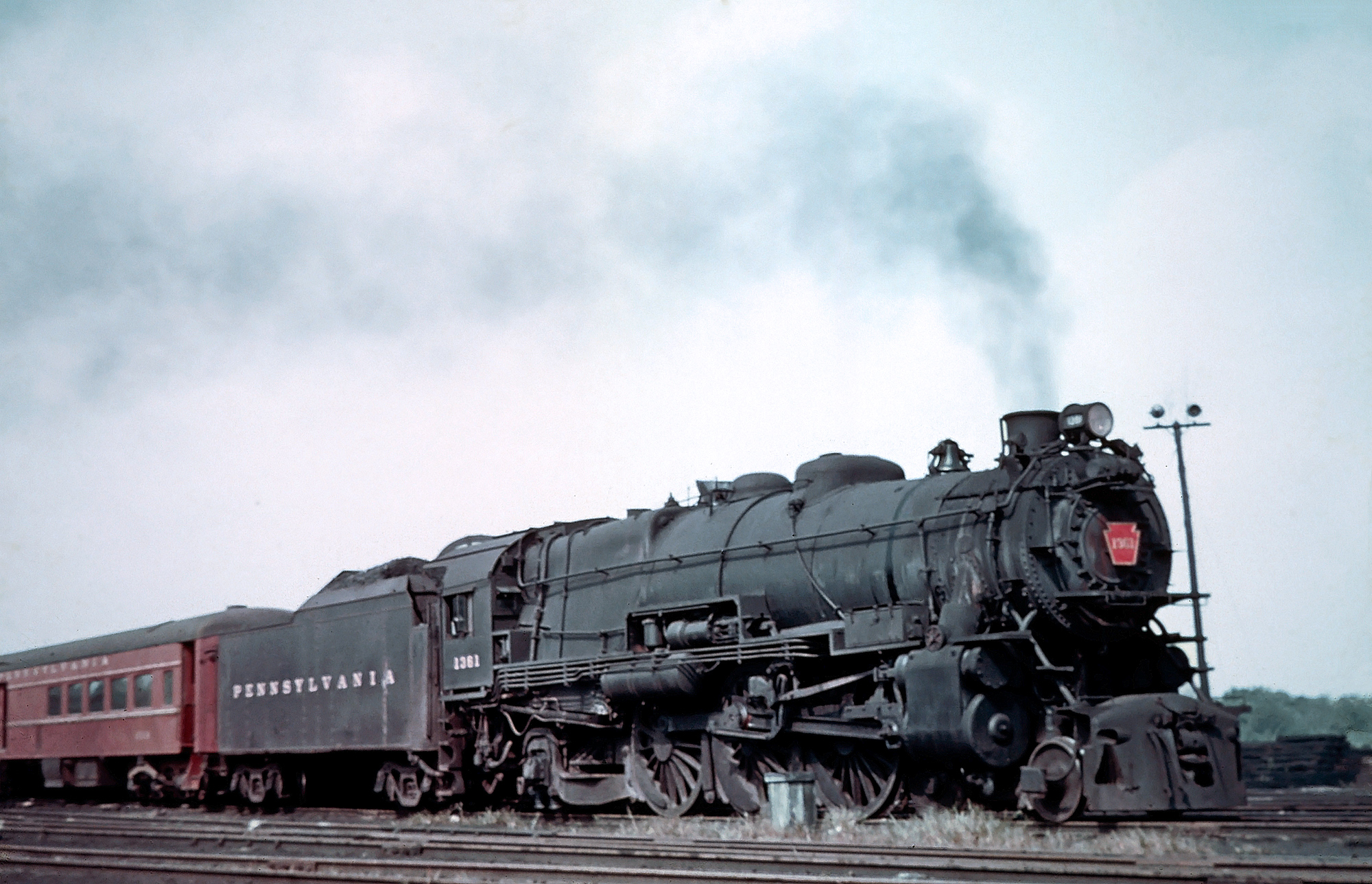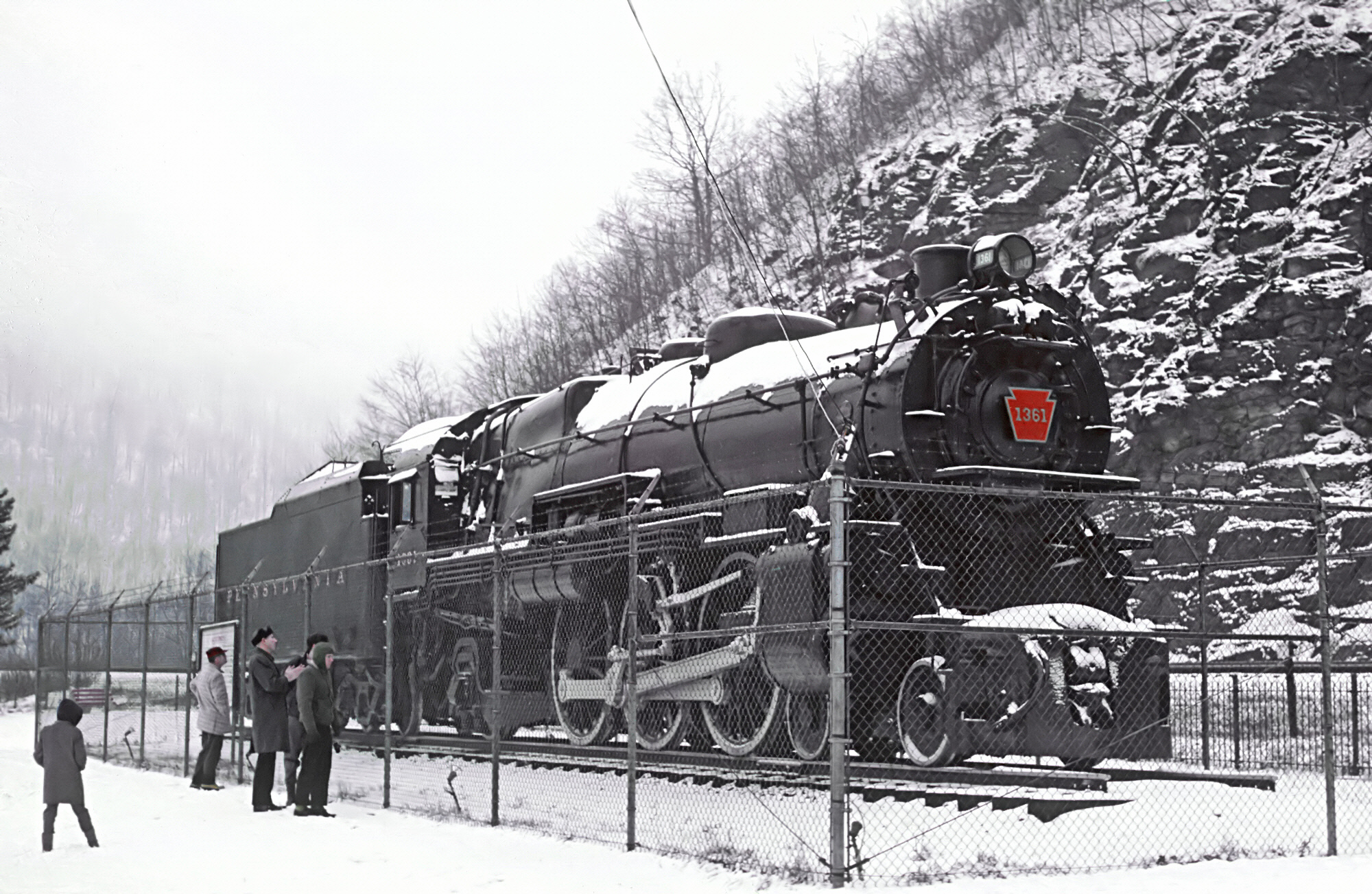PRR 4-6-2 #1361 (K4s): Restoration, Specs, Photos
Last revised: August 25, 2024
By: Adam Burns
Pennsylvania 4-6-2 1361 stands as a testament to an era when steam locomotives dominated America's railways. A 4-6-2 "Pacific" type locomotive, No. 1361, has a rich operational history, impressive specifications, and has been the focus of dedicated preservation efforts.
In regular service the engine played a vital role in hauling mainline passenger trains across Pennsylvania and commuter trains in Central New Jersey until its retirement from revenue service in 1956.
Following an extensive restoration, it returned to operating condition for excursion service in 1987. The Pennsylvania General Assembly honored 1361 alongside its only surviving sister, No. 3750, by designating them as the official state steam locomotives.
Despite being sidelined in 1988 due to mechanical issues, the Pacific is currently under the ownership of the Railroaders Memorial Museum in Altoona, Pennsylvania, where efforts are underway to restore it to operational status once again. This article briefly explores the life and legacy of this iconic engine.
 Pennsylvania 4-6-2 #1361 (K-4s) is seen here in commuter service on the New York & Long Branch at Red Bank, New Jersey, circa 1955. Fred Byerly photo. American-Rails.com collection.
Pennsylvania 4-6-2 #1361 (K-4s) is seen here in commuter service on the New York & Long Branch at Red Bank, New Jersey, circa 1955. Fred Byerly photo. American-Rails.com collection.Brief Overview of the 4-6-2 "Pacific" Type
The 4-6-2 wheel arrangement, known as the "Pacific," became one of the most prevalent steam locomotive types in the early 20th century. The configuration, with four leading wheels, six driving wheels, and two trailing wheels, provided a perfect combination of speed, stability, and power, making it ideal for passenger service.
Operational History
Early Years
1361 was built by the Pennsylvania Railroad's Juniata Shops in Altoona, Pennsylvania, in May 1918. It was one of the K4s-class locomotives, which eventually totaled 425 units. The K4s was designed by Alfred W. Gibbs and Axel Vogt, combining robust engineering with the elegance needed for high-speed passenger service.
1361 quickly became a vital component of the PRR’s fleet, hauling passenger trains across the vast network of lines, primarily in the Northeastern United States. Known for their reliability and speed, the K4s-class engines were instrumental in defining the PRR's reputation for superior passenger service.
Peak Operations
Throughout the 1920s and 1930s, 1361 and its sister engines were the backbone of the railroad's passenger operations. They hauled prestigious trains, such as the Broadway Limited, competing fiercely with rival railroads for passengers traveling between major cities like New York, Philadelphia, and Chicago.
The 1361 served tirelessly, embodying the strength and reliability expected of the Pennsylvania Railroad's flagship locomotives. During World War II, the K4s engines were stretched to their limits, hauling both troop trains and regular passenger services with even greater urgency and frequency.
 During her time on display at Horseshoe Curve, #1361 was photographed here on a snowy February 23, 1969. Roger Puta photo.
During her time on display at Horseshoe Curve, #1361 was photographed here on a snowy February 23, 1969. Roger Puta photo.Decline and Retirement
The post-war years saw a gradual decline in the use of steam locomotives as diesel power became more efficient and economical. By the late 1950s, most K4s locomotives, including 1361, had been retired from active service. The engine was officially retired in 1956, marking the end of an illustrious chapter in Pennsy history.
Specifications
While the operational history of PRR 1361 is impressive, the technical specifications of this locomotive underscore its excellence:
- **Builder**: Juniata Shops
- **Build Date**: May 1918
- **Configuration**: 4-6-2 "Pacific" type
- **Class**: K4s
- **Driver Diameter**: 80 inches (2,032 mm)
- **Engine Weight**: 304,500 pounds (138,100 kg)
- **Tractive Effort**: 44,460 pounds-force (197.7 kN)
- **Boiler Pressure**: 205 psi (1.41 MPa)
- **Cylinder Size**: 27 inches by 28 inches (686 mm by 711 mm)
- **Fuel Type**: Coal
- **Valve Gear**: Walschaerts
These specifications reveal a locomotive designed for power and speed, capable of hauling long passenger trains at high speeds across the PRR’s extensive network.
Preservation Efforts
Initial Preservation
Following its retirement, 1361 was preserved as a static display. In 1957, the locomotive was placed on display at Horseshoe Curve, a National Historic Landmark near Altoona, Pennsylvania. For many years, visitors admired the engine, unaware of the intricate history it carried within its steel frames.
Restoration Attempts
In the 1980s, efforts began to restore 1361 to operational condition. Spearheaded by the restoration enthusiasts of the Railroaders Memorial Museum in Altoona, the project aimed to bring the locomotive back to life. In 1985, the engine was moved to the museum's facilities, where work began in earnest.
By 1987, 1361 was back under steam, making its successful return to operational status after nearly three decades of dormancy. The locomotive thrilled rail enthusiasts by pulling excursions and participating in various events, recapturing the glory of its passenger service days. However, financial and technical challenges soon emerged, necessitating further extensive repairs.
Challenges and Setbacks
The restoration process was plagued by numerous issues. Mechanical troubles, funding shortages, and logistical hurdles resulted in several stalled restoration attempts. Each setback highlighted the complexities and high costs of restoring a century-old steam locomotive to working order.
Reinvigorated Preservation Efforts
Despite the earlier difficulties, efforts to restore 1361 have continued. In recent years, renewed vigor and improved funding mechanisms have supported the cause.
The Railroaders Memorial Museum, partnering with various organizations and volunteers, embarked on an extensive restoration project aimed at finally bringing 1361 back to operational status.
Modern engineering techniques, along with the expertise of dedicated volunteers, have paved the way for a meticulous and thorough restoration process. This includes fabricating new parts, addressing structural issues, and ensuring all components meet modern safety standards while remaining faithful to the original design.
The Importance of Preservation
Preserving 1361 goes beyond merely restoring a piece of machinery; it is about safeguarding a piece of American history. Steam locomotives like this Pacific are tangible links to an era when railroads were the lifeblood of the nation, driving economic growth, facilitating westward expansion, and shaping communities.
Pennsy's K4s-class engines, with their powerful yet graceful design, symbolize the peak of steam locomotive development. By restoring PRR 1361, preservationists are ensuring future generations can experience, firsthand, the marvels of early 20th-century engineering.
Conclusion
The story of 1361 is one of innovation, service, decline, and resurrection. As a 4-6-2 "Pacific" type steam locomotive, it played an essential role in shaping the passenger services of the Pennsy during its heyday.
The locomotive's impressive specifications reflect a design that balanced power and speed, critical for maintaining the railroad's competitive edge.
Current preservation efforts highlight the challenges and dedication required to maintain such a historic machine.
The ongoing work on the engine serves as a beacon of hope, promising a future where this iconic locomotive can once again operate, educating and inspiring generations to come.
The preservation of 1361 is a tribute to all who built, operated, and continue to cherish these iron giants, ensuring their steam whistles and chuffing sounds endure as echoes of America's rich railroad heritage.
Recent Articles
-
New Jersey Short Line Railroads: A Complete Guide
Apr 02, 25 10:29 AM
New Jersey remains an important state to railroading and several short lines operate there. Learn more about these systems here. -
New Hampshire Short Line Railroads: A Complete Guide
Apr 02, 25 10:17 AM
As one of the smallest states, New Hampshire is home to only a few active short lines. Learn more about these railroads here. -
Nebraska Short Line Railroads: A Complete Guide
Apr 02, 25 10:04 AM
Nebraska contains just a few short line railroads, largely concentrated in the handling of agriculture. Learn more about these systems here.